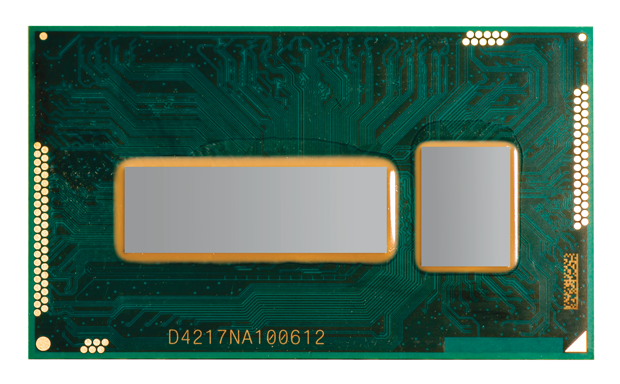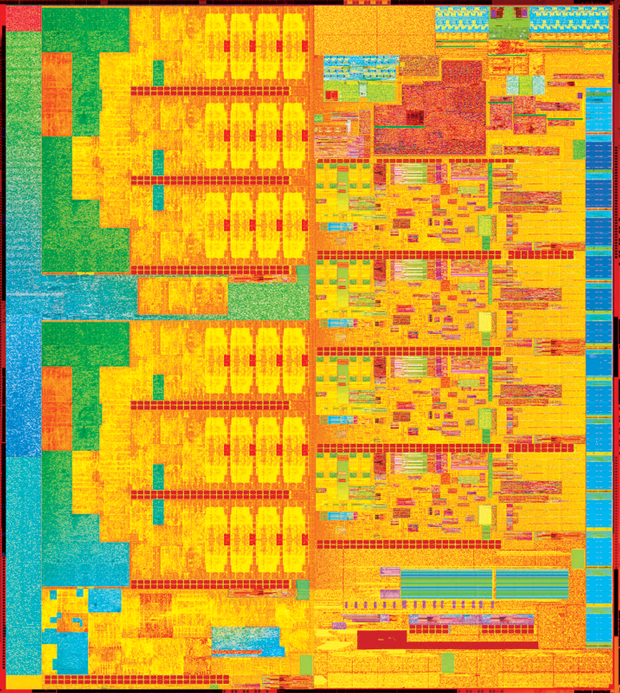Intel’s Processor Progress

The integrated graphics component for fifth-generation CPUs is pictured. Image courtesy of Intel.
Latest News
November 2, 2015
For a long time, NVIDIA was content to be the gaming graphics company, the one supplying hardware that makes the cliffs and waterfalls in “Tomb Raider” more realistic and the explosions in “Battlefield” more spectacular. But about five years ago, NVIDIA began redefining itself by pitching its products as coprocessors for general-purpose computing. The strategy allows the GPU (graphics processing unit) maker to compete in the high-performance computing (HPC) market, what was traditionally the CPU’s territory. NVIDIA’s R&D efforts to build its new persona as a legitimate HPC vendor are not trivial. It reworked its GPU architecture so researchers could deploy GPU-powered clusters in massively parallel operations, from nuclear activity simulation to climate analysis and human genome mapping.
Now it seems the CPU maker Intel is laying the groundwork to redefine itself as more than a CPU maker. The launch of new Intel CPUs with integrated Iris Pro graphics at Computex in September in Taipei, Taiwan marked Intel’s strategy to edge into what has traditionally been the GPU’s market. “Intel is beyond CPU performance. We’ve been working on graphics and imaging over the last few years,” says Kirk Skaugen, senior vice president and general manger, Client Computing, Intel. Jim Blakley, general manager of Visual Cloud Computing at Intel’s Data Center Group, describes the new Intel Xeon E3-1200 V4 processor as “a CPU and GPU on the same chip.” The graphics processing or GPU component in Intel’s new chip is the company’s Iris Pro integrated graphics technology.
Integrated Graphics vs. Add-on GPU
Intel HD Graphics, Iris and Iris Pro graphics are all designed to provide a visual computing boost in gaming and video — straight from the CPU’s architecture. “Integrated graphics have a lower bill of materials, smaller footprint and lower power envelope,” says Skaugen.
In its product sheet for Xeon E3-1200 V4, Intel writes: “The tight integration of compute and graphics in the same processor increases performance and density, while reducing power consumption and data movement.” The implication is, because the graphics component is built into the chip itself, Intel’s integrated graphics technology is a better alternative to a discrete GPU, which needs to communicate with the CPU through a connector.
NVIDIA offers the Quadro product line for workstation users running mainstream CAD software, and the higher-end Tesla cards for HPC and simulation software users. In its current incarnation, Intel’s Iris Pro might go head-to-head with NVIDIA’s Quadro product line in some applications (for example, video editing, 3D content viewing, and 3D modeling); however, it’s not reaching into the HPC and simulation software user markets served by NVIDIA Tesla. “Iris Pro graphics is not meant to compete in the high-end GPU market. The performance of Iris Pro is roughly equivalent of a mainstream graphics card,” Blakley says.Most professional workstations — even entry-level brands — come equipped with discrete graphics cards; therefore, once Intel CPUs with integrated graphics become the norm in processor choices, workstation users would have two graphics options: through the CPU’s integrated graphics and through the discrete GPU. Workstation users could therefore put both to use at the same time. For example, they may use the CPU’s integrated graphics for video editing and assign the discrete GPU to take on the more demanding CAD visualization. But relying on the CPU’s integrated graphics to the exclusion of the discrete GPU may not be the best course of action.
“Workstation users running CAD applications tend to want the best graphics, best visualization, and that’s what they get with the discrete graphics card. You can’t usually get the same level of graphics performance with integrated graphics,” says Scott Hamilton, vertical marketing strategist, Dell. Hamilton pointed out that integrated graphics tend to use less energy; therefore, it could be the preferred option for mobile workstation users doing light to medium modeling work on the road and need to conserve battery life.
“Discrete GPUs in the professional space are here to stay. Discrete GPU makers AMD and NVIDIA tweak their drivers all the times to make sure the ISVs (independent software vendors) get the best performance from their products. Iris Pro could replace the discrete graphics card in some entry-level applications. But for integrated graphics to become a viable alternative to discrete graphics, Intel would have to make the same investment in ISV certifications, recruiting ISVs to qualify their drivers, adding performance modes and plug-ins, and so on,” says Rahul Tikoo, general manager for Workstation End User Computing, Dell.
Tikoo pointed out Dell does offer some desktop tower models without a discrete GPU. “Our suspicion is, most of those buyers already have a discrete graphics card or have a way to acquire it on their own. So it doesn’t mean they’re running their applications solely with integrated graphics. Most likely, they’re adding the GPU to the machine on their own,” he says.
Supporting Integrated Graphics
The appeal of the GPU as a coprocessor expanded when NVIDIA developed CUDA (compute unified device architecture), the company’s proprietary GPU-based programming language for writing massively parallel applications. Nurturing the CUDA community took time. About five years after its debut, CUDA is finally finding a home among some simulation and visualization software vendors. This NVIDIA-ISV partnership was crucial to the company’s strategy to redefine the discrete graphics card as a number crunching, parallel-processing engine. The GPU’s value proposition also increases as more mainstream 3D software vendors began to implement GPU-accelerated visualization.
Intel argues supporting integrated graphics will be much more straightforward. “If the application is written to use OpenGL or DirectX, then Iris Pro works without any additional programming effort. NVIDIA also supports OpenGL and DirectX. These are graphics programming APIs. If you want to do things that are more compute-oriented, then we support OpenCL programming on the GPU. This is the direct comparison with CUDA. Whereas CUDA is proprietary NVIDIA programming model, OpenCL is industry standard,” says Blakley.
In an Intel-produced podcast titled Chip Chat, Blakley said the Xeon E3-1200 V4 offers “substantial performance over previous generations.” He says: “We get up to almost 2x in graphics improvement overall, almost 2x in media processing and video transcoding” (Chip Chat, June 10, 2015).
Though Intel has never confirmed it officially, the chipmaker is believed to follow the tick-tock rhythm in its technology releases — tick is a refinement; tock is a major architecture overhaul. The Xeon E3-1200 V4 falls into the tick slot, which may explain the ISVs’ subdued reaction. Software makers tend to devote more R&D efforts to align their products with the chipmaker’s tock chip releases.
The anticipated tock for the near future is the new chip architecture codenamed Skylake. These new processors are expected to deliver, in Intel’s estimates, 1.6x better productivity, 6x faster video conversion, 2x faster media editing, and 13x better graphics (compared to five-year-old PCs). Designed with IoT (Internet of Things) devices and remote computing in mind, Skylake processors promise superior user experiences in all-in-one PCs and mobile devices.
Redefining the CPU, the Xeon Brand
In early September, Intel began sharing details about its upcoming 6th generation Intel Core processor family, codenamed Skylake. It’s described as “the company’s best processors ever.” Intel writes: “The launch marks a turning point in people’s relationship with computers.”
In the same announcement, Intel reveals its roadmap to bolster its integrated graphics. “In the coming months, Intel plans to deliver more than 48 processors in the 6th Gen Intel Core processor family, featuring Intel Iris and Iris Pro graphics, as well as Intel Xeon E3-1500M processor family for mobile workstations and 6th Gen Intel vPro processors for business and enterprises,” the company states.
“Going forward, we’ll add substantially better improvement to Iris Pro. We’ll be developing more and more GPU features and continuing to increase its performance,” says Blakley.
A month earlier, Intel also wrote in a blog post that they have “plans to bring the power of Intel Xeon processors to notebook PCs for the first time.” Xeon is usually associated with professional desktop workstations, but the new Intel Xeon Processor E3-1500M v5 product family, according to Intel: “[Is] based on the next-gen Skylake architecture and they will deliver high precision computing horsepower in notebook form factors … Intel Xeon-based mobile workstations will have key features such as error-correcting code memory that automatically detects and repairs errors on-the-fly that cause data corruption and system crashes for peace-of-mind reliability.”
In its early incarnation, Intel’s integrated graphics competes with the discrete graphics card in narrowly defined entry-level fields. Currently, the CPU with integrated graphics is more a complementary technology than a rival to the GPU. The combo offers users the chance to split his or her graphics workload between two computing resources. But if Intel ramps up its R&D efforts to bring the performance of integrated graphics to a level that’s comparable to a discrete GPU, and if users begin exploring its potential to do general-purpose computing, the chipmaker can seriously disrupt the established market dynamics in visual computing and HPC markets.
Subscribe to our FREE magazine, FREE email newsletters or both!
Latest News
About the Author
Kenneth Wong is Digital Engineering’s resident blogger and senior editor. Email him at [email protected] or share your thoughts on this article at digitaleng.news/facebook.
Follow DE







